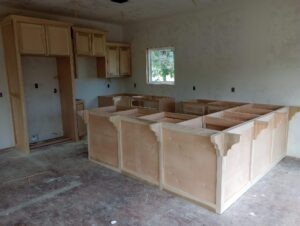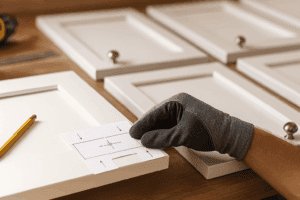Water damage, warping, or general wear can leave you wondering how to replace the bottom of a cabinet. As a third-generation cabinet maker serving Oklahoma for decades, I’ve helped countless homeowners tackle this common repair. Learning how to replace the bottom of a cabinet properly can save you hundreds of dollars and extend your kitchen’s life significantly.
When You Need to Replace the Bottom of a Cabinet
Before diving into how to replace the bottom of a cabinet, it’s important to identify when replacement is necessary versus when repairs might suffice.
Signs You Need Cabinet Bottom Replacement
Water Damage Indicators:
- Soft, spongy wood that compresses under pressure
- Dark stains or discoloration throughout the bottom panel
- Musty odors emanating from the cabinet interior
- Visible mold or mildew growth on the surface
Structural Issues:
- Sagging or warped bottom panels affecting door alignment
- Cracks extending across the entire width of the bottom
- Separation between the bottom panel and cabinet sides
- Items falling through deteriorated sections
Wear and Tear Problems:
- Deep scratches or gouges compromising the wood integrity
- Multiple holes from previous hardware installations
- Delamination in plywood or particle board bottoms
Tools and Materials for Cabinet Bottom Replacement
Knowing how to replace the bottom of a cabinet starts with gathering the right supplies. Here’s what you’ll need:
Essential Tools
- Circular saw or jigsaw for cutting new bottom panel
- Drill with various bits for pilot holes and screws
- Screwdriver set (both flathead and Phillips head)
- Measuring tape and pencil for accurate marking
- Level to ensure proper alignment
- Safety glasses and dust mask for protection
- Sandpaper (120 and 220 grit) for finishing
Required Materials
- New bottom panel (¾-inch plywood or particle board)
- Wood screws (1¼-inch length recommended)
- Wood glue for additional strength
- Cabinet bottom brackets or cleats
- Wood stain or paint to match existing finish
- Polyurethane finish for moisture protection
Step-by-Step Guide: How to Replace the Bottom of a Cabinet
Step 1: Remove Cabinet Contents and Doors
Before learning how to replace the bottom of a cabinet effectively, you must create adequate working space.
Complete Removal Process:
- Remove all items stored in the cabinet completely
- Take photos of door hinge positions for easier reinstallation
- Unscrew hinges from cabinet doors and set aside safely
- Remove any drawers or pull-out shelves that might interfere
- Clean the interior thoroughly to assess damage extent
Step 2: Remove the Damaged Bottom Panel
Understanding how to replace the bottom of a cabinet requires careful removal of the old material.
Safe Removal Technique:
- Look for screws securing the bottom panel from underneath
- Use a drill to remove all visible screws carefully
- Check for adhesive or nails holding the panel in place
- Gently pry the damaged bottom panel free using a pry bar
- Clean any remaining debris or old adhesive from the frame
Important Note: Some cabinet bottoms are dadoed (set in grooves) into the side panels. If this is the case, you may need to cut the old bottom into smaller pieces for removal.
Step 3: Measure and Cut the New Bottom Panel
Precision is crucial when learning how to replace the bottom of a cabinet properly.
Accurate Measuring Process:
- Measure the interior width of the cabinet from side to side
- Measure the interior depth from front rail to back panel
- Account for any irregularities or slight variations in measurements
- Subtract ⅛ inch from each dimension for easier installation
- Mark your measurements clearly on the new panel material
Professional Cutting Tips:
- Use a circular saw with a fine-tooth blade for clean cuts
- Support both sides of the cut to prevent splintering
- Cut with the good side of the panel facing down
- Sand cut edges smooth with 120-grit sandpaper
Step 4: Install the New Cabinet Bottom
Here’s the critical part of how to replace the bottom of a cabinet successfully.
Proper Installation Method:
- Test fit the new bottom panel before permanent installation
- Apply a thin bead of wood glue to the cabinet frame edges
- Position the panel carefully, ensuring even gaps on all sides
- Use clamps to hold the panel in place temporarily
- Drill pilot holes to prevent splitting the wood
- Secure with 1¼-inch wood screws every 8-10 inches around the perimeter
- Wipe away any excess glue immediately with a damp cloth
Step 5: Finish and Reinstall Cabinet Components
Completing the cabinet bottom replacement properly ensures long-lasting results.
Final Steps:
- Sand the new bottom panel with 220-grit sandpaper
- Apply stain or paint to match the existing cabinet finish
- Once dry, apply two coats of polyurethane for moisture protection
- Allow 24 hours for complete curing before use
- Reinstall doors, drawers, and hardware using your reference photos
Common Mistakes When Replacing Cabinet Bottoms
Learning how to replace the bottom of a cabinet includes avoiding these frequent errors:
Measurement Errors
- Failing to account for cabinet frame thickness
- Not measuring multiple points (cabinets aren’t always perfectly square)
- Forgetting to subtract space for expansion and contraction
Material Selection Issues
- Using particle board in high-moisture areas
- Choosing material too thin for the cabinet span
- Selecting wood that doesn’t match the cabinet construction
Installation Problems
- Skipping pilot holes and splitting the wood
- Over-tightening screws and creating dimples
- Forgetting to seal edges in moisture-prone areas
When to Call a Professional vs. DIY
While learning how to replace the bottom of a cabinet is manageable for many homeowners, certain situations require professional expertise.
DIY-Friendly Scenarios
- Single cabinet with straightforward damage
- Standard rectangular cabinet construction
- Access to necessary tools and materials
- Comfortable with basic carpentry skills
Professional Installation Recommended
- Multiple cabinets requiring bottom replacement
- Custom or unusual cabinet construction
- Extensive water damage affecting the cabinet structure
- Lack of proper tools or workspace
Preventing Future Cabinet Bottom Damage
After learning how to replace the bottom of a cabinet, prevention becomes crucial for long-term success.
Moisture Protection Strategies
- Install proper ventilation in kitchen and bathroom areas
- Address plumbing leaks immediately when discovered
- Use waterproof mats under sinks and appliances
- Apply quality sealant around plumbing penetrations
Regular Maintenance Tips
- Inspect cabinet bottoms quarterly for early damage signs
- Clean spills immediately to prevent moisture penetration
- Touch up finish annually in high-use areas
- Replace worn shelf liners that might trap moisture
Cost Comparison: DIY vs. Professional Replacement
Understanding the financial aspects of how to replace the bottom of a cabinet helps make informed decisions.
DIY Cost Breakdown
- New bottom panel: $15-40 depending on size and material
- Hardware and supplies: $10-20 for screws, glue, and finish
- Tool rental (if needed): $20-50 for specialized equipment
- Total DIY cost: $45-110 per cabinet
Professional Installation Costs
- Labor charges: $75-150 per cabinet depending on complexity
- Materials: $25-50 (professional markup included)
- Total professional cost: $100-200 per cabinet
Advanced Tips for Cabinet Bottom Replacement
These professional insights on how to replace the bottom of a cabinet come from three generations of experience:
Strengthening Techniques
- Add corner braces for extra support on larger cabinets
- Use construction adhesive in addition to screws for maximum strength
- Consider upgrading to thicker material if the original was inadequate
Finishing Secrets
- Sand between coats for a smooth, professional appearance
- Use grain filler on oak or other open-grain woods
- Apply stain with the grain direction for even color distribution
Troubleshooting Common Issues
When learning how to replace the bottom of a cabinet, you might encounter these challenges:
Uneven Cabinet Frames
- Use shims to level the bottom panel before securing
- Consider scribing the panel to fit irregular openings
- Check that the cabinet itself isn’t racked or twisted
Matching Existing Finish
- Take a sample to your paint store for color matching
- Test stain on a hidden area first
- Consider aging techniques for better blend with older cabinets
Regional Considerations for Oklahoma Homeowners
Based on decades serving Eastern Oklahoma, here are specific considerations for how to replace the bottom of a cabinet in our climate:
Humidity Concerns
Oklahoma’s variable humidity requires special attention to wood movement and moisture protection. Use marine-grade finishes in high-humidity areas.
Material Availability
Local lumber yards often stock cabinet-grade plywood suitable for bottom replacement. Consider supporting local Oklahoma suppliers for faster availability and better prices.
Long-Term Cabinet Care After Bottom Replacement
Successfully completing how to replace the bottom of a cabinet is just the beginning. Proper ongoing care ensures your investment lasts:
Monthly Inspections
- Check for new moisture intrusion signs
- Ensure door alignment remains proper
- Look for loose screws or hardware
Annual Maintenance
- Reapply protective finish to high-wear areas
- Tighten any loose cabinet hardware
- Address minor issues before they become major problems
Getting Professional Help in Eastern Oklahoma
While this guide covers how to replace the bottom of a cabinet comprehensively, sometimes professional expertise is valuable. At The Cabinet Craftsmen LLC, our three generations of experience help homeowners throughout Eastern Oklahoma with cabinet repairs and replacements.
Whether you’re tackling the project yourself or need professional assistance, contact us for expert guidance on your cabinet bottom replacement project.
Conclusion
Learning how to replace the bottom of a cabinet empowers homeowners to address common kitchen problems efficiently and cost-effectively. With proper tools, materials, and techniques, cabinet bottom replacement becomes a manageable DIY project that can save significant money while extending your kitchen’s functional life.
Remember, the key to successful cabinet bottom replacement lies in careful measurement, proper material selection, and attention to finishing details. Whether you choose to tackle this project yourself or work with experienced professionals, understanding the process helps ensure the best possible results for your kitchen investment.
Ready to start your cabinet bottom replacement project? For expert advice and professional cabinet services in Eastern Oklahoma, visit The Cabinet Craftsmen LLC today.
This article contains affiliate links, which means we may earn a small commission at no extra cost to you if you click through and make a purchase.

